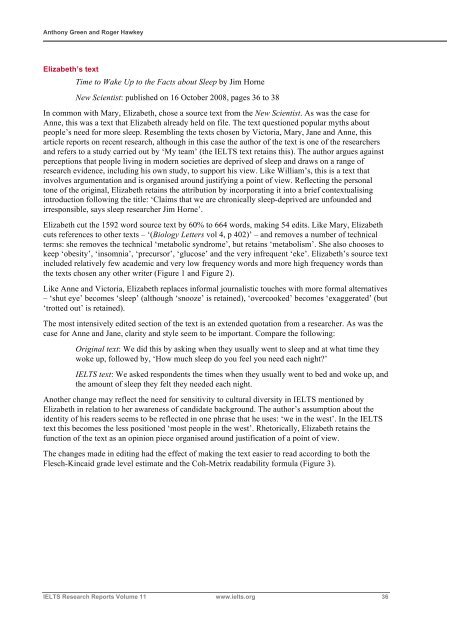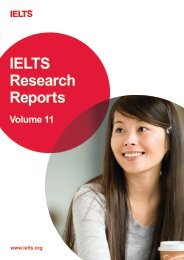An investigation of the process of writing IELTS Academic Reading ...
An investigation of the process of writing IELTS Academic Reading ...
An investigation of the process of writing IELTS Academic Reading ...
You also want an ePaper? Increase the reach of your titles
YUMPU automatically turns print PDFs into web optimized ePapers that Google loves.
<strong>An</strong>thony Green and Roger Hawkey<br />
Elizabeth’s text<br />
Time to Wake Up to <strong>the</strong> Facts about Sleep by Jim Horne<br />
New Scientist: published on 16 October 2008, pages 36 to 38<br />
In common with Mary, Elizabeth, chose a source text from <strong>the</strong> New Scientist. As was <strong>the</strong> case for<br />
<strong>An</strong>ne, this was a text that Elizabeth already held on file. The text questioned popular myths about<br />
people’s need for more sleep. Resembling <strong>the</strong> texts chosen by Victoria, Mary, Jane and <strong>An</strong>ne, this<br />
article reports on recent research, although in this case <strong>the</strong> author <strong>of</strong> <strong>the</strong> text is one <strong>of</strong> <strong>the</strong> researchers<br />
and refers to a study carried out by ‘My team’ (<strong>the</strong> <strong>IELTS</strong> text retains this). The author argues against<br />
perceptions that people living in modern societies are deprived <strong>of</strong> sleep and draws on a range <strong>of</strong><br />
research evidence, including his own study, to support his view. Like William’s, this is a text that<br />
involves argumentation and is organised around justifying a point <strong>of</strong> view. Reflecting <strong>the</strong> personal<br />
tone <strong>of</strong> <strong>the</strong> original, Elizabeth retains <strong>the</strong> attribution by incorporating it into a brief contextualising<br />
introduction following <strong>the</strong> title: ‘Claims that we are chronically sleep-deprived are unfounded and<br />
irresponsible, says sleep researcher Jim Horne’.<br />
Elizabeth cut <strong>the</strong> 1592 word source text by 60% to 664 words, making 54 edits. Like Mary, Elizabeth<br />
cuts references to o<strong>the</strong>r texts – ‘(Biology Letters vol 4, p 402)’ – and removes a number <strong>of</strong> technical<br />
terms: she removes <strong>the</strong> technical ‘metabolic syndrome’, but retains ‘metabolism’. She also chooses to<br />
keep ‘obesity’, ‘insomnia’, ‘precursor’, ‘glucose’ and <strong>the</strong> very infrequent ‘eke’. Elizabeth’s source text<br />
included relatively few academic and very low frequency words and more high frequency words than<br />
<strong>the</strong> texts chosen any o<strong>the</strong>r writer (Figure 1 and Figure 2).<br />
Like <strong>An</strong>ne and Victoria, Elizabeth replaces informal journalistic touches with more formal alternatives<br />
– ‘shut eye’ becomes ‘sleep’ (although ‘snooze’ is retained), ‘overcooked’ becomes ‘exaggerated’ (but<br />
‘trotted out’ is retained).<br />
The most intensively edited section <strong>of</strong> <strong>the</strong> text is an extended quotation from a researcher. As was <strong>the</strong><br />
case for <strong>An</strong>ne and Jane, clarity and style seem to be important. Compare <strong>the</strong> following:<br />
Original text: We did this by asking when <strong>the</strong>y usually went to sleep and at what time <strong>the</strong>y<br />
woke up, followed by, ‘How much sleep do you feel you need each night?’<br />
<strong>IELTS</strong> text: We asked respondents <strong>the</strong> times when <strong>the</strong>y usually went to bed and woke up, and<br />
<strong>the</strong> amount <strong>of</strong> sleep <strong>the</strong>y felt <strong>the</strong>y needed each night.<br />
<strong>An</strong>o<strong>the</strong>r change may reflect <strong>the</strong> need for sensitivity to cultural diversity in <strong>IELTS</strong> mentioned by<br />
Elizabeth in relation to her awareness <strong>of</strong> candidate background. The author’s assumption about <strong>the</strong><br />
identity <strong>of</strong> his readers seems to be reflected in one phrase that he uses: ‘we in <strong>the</strong> west’. In <strong>the</strong> <strong>IELTS</strong><br />
text this becomes <strong>the</strong> less positioned ‘most people in <strong>the</strong> west’. Rhetorically, Elizabeth retains <strong>the</strong><br />
function <strong>of</strong> <strong>the</strong> text as an opinion piece organised around justification <strong>of</strong> a point <strong>of</strong> view.<br />
The changes made in editing had <strong>the</strong> effect <strong>of</strong> making <strong>the</strong> text easier to read according to both <strong>the</strong><br />
Flesch-Kincaid grade level estimate and <strong>the</strong> Coh-Metrix readability formula (Figure 3).<br />
<strong>IELTS</strong> Research Reports Volume 11 www.ielts.org 36

















